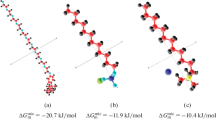Abstract
Due to the spherical shape with a diameter of ca. 1 nm, the aggregation behaviour of fullerene C60 is very interesting in view of the possible formation of magic number particle in a similar manner as metal cluster in gas phase. Herein, we report for the first time the magic number aggregation behaviours of polyhydroxylated fullerenol C60(OH)36 in water–alcohol (methanol, ethanol and 1-propanol) binary solution with increasing alcohol component. The diameters of particle were ca. 6–8 nm depending on the alcohol used. The particle sizes were precisely measured by the novel-induced grating method which is superior for the particle-size measurement in single-nano region (1–10 nm). The magic number cluster was also detected by scanning probe microscopy observation. However, such aggregation behaviours were not found in DMSO–alcohol system or for the use of less hydroxylated C60(OH)10.









Similar content being viewed by others
References
Anagnostatos GS (1987) Magic numbers in small clusters of rare-gas and alkali atoms. Phys Lett A 124:85–89
Bhuiyan MMH, Ferdaush J, Uddin MH (2007) Density and viscosities of binary mixtures of dimethylsulfoxide + aliphatic lower alkanols (C1–C3) at temperatures from T = 303.15 K to T = 323.15 K. J Chem Thermodyn 39:675–683
Boyen H-G, Kästle G, Weigl F, Koslowski B, Dietrich C, Ziemann P, Spats JP, Riethmüller S, Hartmann C, Möller M, Schmid G, Garnier MG, Oelhafen P (2002) Oxidation-resistant gold-55 clusters. Science 297:1533–1536
Brant J, Lecoanet H, Wiesner MR (2005) Aggregation and deposition characteristics of fullerene nanoparticles in aqueous systems. J Nanopart Res 7:545–553
Branz W, Malinowski N, Enders A, Martin TP (2002) Structural transition on (C60)n clusters. Phys Rev B 66:094107
Chae S-R, Hotze EM, Wiesner MR (2009) Evaluation of the oxidation of organic compounds by aqueous suspensions of photosensitized hydroxylated-C60 fullerene aggregates. Environ Sci Technol 43:6208–6213
Deguchi S, Mukai S, Tsudome M, Horikoshi K (2006) Facile generation of fullerene nanoparticles by hand-grinding. Adv Mater 18:729–732
Garvey JF, Herron WJ, Vaidyanathan G (1994) Probing the structure and reactivity of hydrogen-bonded clusters of the type {M}n{H2O}H+, via the observation of magic numbers. Chem Rev 94:1999–2014
González B, Calvar N, Gómez E, Domínguez Á (2007) Density, dynamic viscosity, and derived properties of binary mixtures of methanol or ethanol with water, ethyl acetate, and methyl acetate at T = (293.15, 298.15, and 303.15) K. J Chem Thermodyn 39:1578–1588
Grande MdC, García M, Marschoff CM (2009) Density and viscosity of anhydrous mixtures of dimethylsulfoxide with acetonitrile in the range (298.15 to 318.15) K. J Chem Eng Data 54:652–658
Hansen K, Hohmann H, Müller R, Campbell EEB (1996) Icosahedra of icosahedra: the stability of (C60)13. J Chem Phys 105:6088–6089
Kokubo K, Matsubayashi K, Tategaki H, Takada H, Oshima T (2008) Facile synthesis of highly water-soluble fullerenes more than half-covered by hydroxyl groups. ACS Nano 2:327–333
Kokubo K, Shirakawa S, Kobayashi N, Aoshima H, Oshima T (2011) Facile and scalable synthesis of a highly hydroxylated water-soluble fullerenol as a single nanoparticle. Nano Res 4:204–215
Kyzyma OA, Korobov MV, Avdeev MV, Garamus VM, Snegir SV, Petrenko VI, Aksenov VL, Bulavin LA (2010) Aggregate development in C60/N-methyl-2-pyrrolidone solution and its mixture with water as revealed by extraction and mass spectroscopy. Chem Phys Lett 493:103–106
Liu Y, Zhang G, Niu L, Gan L, Liang D (2011) Assembly of Janus fullerenol: a novel approach to prepare rich carbon structures. J Mater Chem 21:14864–14868
Martin TP, Näher P, Schaber H, Zimmermann U (1993) Clusters of fullerene molecules. Phys Rev Lett 70:3079–3082
Mikhail SZ, Kimel WR (1963) Densities and viscosities of 1-propanol–water mixtures. J Chem Eng Data 8:323–328
Mohan H, Palit DK, Mittal JP, Chiang LY, Asmus K-D, Guldi DM (1998) Excited states and electron transfer reactions of C60(OH)18 in aqueous solution. J Chem Soc Faraday Trans 94:359–363
Nath S, Pal H, Palit DK, Sapre AV, Mittal JP (1998) Aggregation of fullerene, C60, in benzonitrile. J Phys Chem B 102:10158–10164
Rodríguez-Zavala JG, Barajas-Barraza RE, Padilla-Osuna I, Guirado-López RA (2011) Hydration behaviour of polyhydroxylated fullerenes. J Phys B 44:205104–205117
Sakurai M, Watanabe K, Sumiyama K, Suzuki K (1999) Magic numbers in transition metal (Fe, Ti, Zr, Nb, and Ta) clusters observed by time-of flight mass spectrometry. J Chem Phys 111:235–238
Sattler K (1993) C60 and beyond: from magic numbers to new materials. Jpn J Appl Phys 32:1428–1432
Semenov KN, Charykov NA, Keskinov VN (2011) Fullerenol synthesis and identification. Properties of the fullerenol water solution. J Chem Eng Data 56:230–239
Wada Y, Totoki S, Watanabe M, Moriya N, Tsunazawa Y, Shimaoka H (2006) Nanoparticle size analysis with relaxation of induced grating by dielectrophoresis. Opt Express 14:5755–5764
Wakisaka A, Komatsu S, Usui Y (2001) Solute–solvent and solvent–solvent interactions evaluated through clusters isolated from solutions: preferential solvation in water–alcohol mixtures. J Mol Liq 90:175–184
Ying Q, Marecek J, Chu B (1994) Slow aggregation of buckminsterfullerene (C60) in benzene solution. Chem Phys Lett 219:214–218
Young LDR, Fink AL, Dill KA (1993) Aggregation of globular proteins. Acc Chem Res 26:614–620
Acknowledgments
This study was supported by JSPS KAKENHI of a Grant-in-Aid for Challenging Exploratory Research No. 23651111 and by Health Labour Sciences Research Grants from MHLW of Japan. The authors thank Shimadzu Corporation for collaborative measurements on IG and SPM analysis.
Author information
Authors and Affiliations
Corresponding author
Rights and permissions
About this article
Cite this article
Nakamura, Y., Ueno, H., Kokubo, K. et al. Magic number effect on cluster formation of polyhydroxylated fullerenes in water–alcohol binary solution. J Nanopart Res 15, 1755 (2013). https://doi.org/10.1007/s11051-013-1755-6
Received:
Accepted:
Published:
DOI: https://doi.org/10.1007/s11051-013-1755-6




